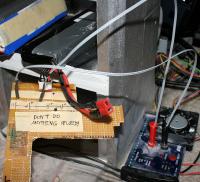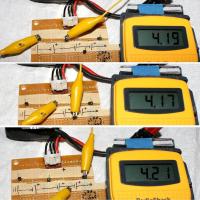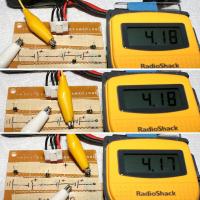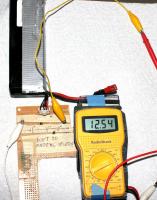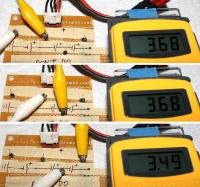| Thread Tools |
| This thread is privately moderated by Jack Crossfire, who may elect to delete unwanted replies. |
|
|
|
|
|
Discussion
Unbalanced battery terrorism
So the 4Ah has over 90 recharges and its flight time is 14% lower. It appears one cell is the weak link. When charged in parallel, 2 cells are getting overcharged waiting for the weak cell to charge, a lethal condition. It's probably going to be charging on a battery balancer until retirement.
Considering it takes $100 of batteries to fly for 50 hours and it takes $300 of gas to drive for 50 hours, it's 1/3 as costly to fly. Meanwhile, been trying to recover the $165 investment in Gumstix Corporation's CEO as fast as possible. # ls -al drwxr-xr-x 2 root root 0 Dec 31 16:01 . drwxr-xr-x 19 root root 0 Dec 31 16:00 .. -rw-r--r-- 1 root root 0 Oct 26 2006 .bash_history -rw-r--r-- 1 root root 175 Oct 26 2006 .bash_logout -rw-r--r-- 1 root root 161 Oct 26 2006 .bash_profile -rw-r--r-- 1 root root 1711 Oct 26 2006 .bashrc -rwxr-xr-x 1 root root 2540 Feb 22 2007 arm_copter # ./arm_copter Hello world # So the answer is yes. You can cross compile for the Gumstix, upload to the flash using zmodem, and run. It doesn't need removable storage or a new root image every time. Recall the embedded systems at your day job, $1500 BD players, $10,000 plasmas, $1000 cameras have always used read-only filesystems. The $165 Gumstix is quite an improvement with a writable flash filesystem. We have serial communication between the PC, Gumstix and PIC. The next flight test requires 4 communication paths to work perfectly: the 2 serial paths and 2 radio paths. Autopilot shutdown must be tested and retested. Implementing avionics is long and hard. The possibility of a speed governer in the avionics is intriguing. It would be much more accurate than a throttle curve and delay $350 of the TRex 600 tag. Tachometers merely probe ESC output levels. Should be noted that an autopilot doesn't work like a human. A human compares what it sees with every possible memory and sends a memorized muscle response based on the closest image match. A computer computes a logical muscle response from scratch for every acceleration reading. A human initially computes logical muscle responses but falls over to its much faster comparison algorithm after memorizing enough images. Humans are the ultimate data comparators indeed, for now. ImagesView all Images in thread
|
|
|
Last edited by Jack Crossfire; Feb 25, 2007 at 12:42 AM.
|
|
|
|
